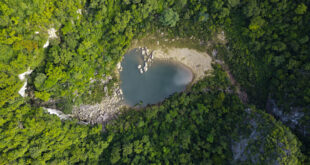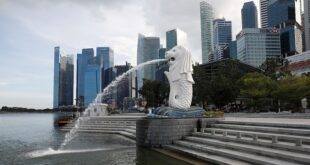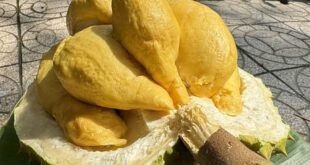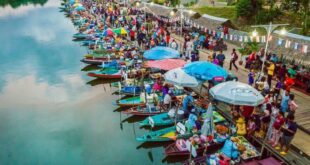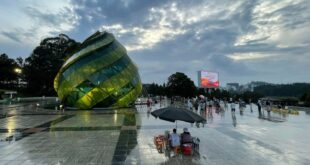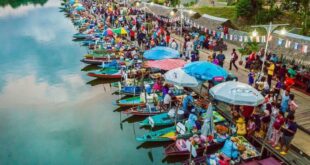Ho Chi Minh City is home to some of the country’s most significant historical sites, particularly those related to the Vietnam War.
These sites, called “red addresses”, witnessed some of the most turbulent history of the Vietnam War. The sites include secret bases, old administrative buildings and tunnels that visitors can get their hands dirty exploring.
The Saigon Special Force weapons bunker
Address: 287/70, Nguyen Dinh Chieu Street, Ward 5, District 3
 |
|
The weapons bunker covers an area of about 70 meters square. Photo by VnExpress/ Quynh Tran |
In 1966, Tran Van Lai (aka Nam Lai) from the Saigon Special Force guerilla group, bought a house to store weapons for attacks on the Independence Palace, which was then headquarters of the South Vietnam government, during the 1968 Tet Offensive.
The Saigon Special Force was the name of a southern liberation task force which specialized in raids aimed at the Saigon regime and U.S. military forces in Saigon during the Vietnam War from 1955 to 1975. Van Lai pretended to renovate the house to avoid suspicion, moved his wife and children to Go Vap District, and stayed at the site to construct the secret armory. After seven months, he completed the cellar, which was two meters long, 1.2 meters wide, and 2.5 meters high, with four exits. He used thick waterproof cement for the walls and floors.
More than two tons of weapons were hidden in the bunker from 1966 to 1968. Today, the iron door of the house still has bullet marks. The site has been open to visitors since 2018 and now features a cafe displaying many artifacts related to the activities of the Saigon Special Force. This is an official National Cultural Historic Site.
Pho Binh
Address: 7 Ly Chinh Thang Street, District 3
 |
|
Pho Binh noodle shop was recognized as a National Historic Site in 1989. Photo by mvid |
The Pho Binh noodle shop was a front for the headquarters of Division 6 during the 1968 Spring Mau Than General Offensive and Uprising (The Tet Offensive). In 1966, revolutionaries Ngo Toai and Nguyen Van Tri (Hai Tri), one of the officers in charge of the combat support unit of the Special Force, worked together to make this a place where guerilla leaders and foot soldiers could communicate secretly at a safe location, hidden in plain sight.
To avoid suspicion, the owner ran a pho restaurant, and guerillas worked as employees. But the back rooms were used for secret meetings. The shop was busy every day with regular pho customers, so the enemy did not notice anything. Revolutionary heroes used Pho Binh to plan their attacks for the Tet Offensive, but after the attack, the eatery was exposed, and some soldiers were captured. Ngo Toai and his wife were later arrested and sent to Con Dao Prison. In 1988, the room where all the planning happened was recognized as a National Historic Site by the Ministry of Culture. The pho shop is still selling delicious noodles after more than 50 years.
The Saigon Special Force’s secret mailbox and bunker
Address: 113A Dang Dung Street, Tan Dinh Ward, District 1
 |
|
This place was once a secret communication station for the Saigon Special Force. Photo by daily.photo_diary |
Before 1975, this broken rice eatery was once a secret communication station of the Saigon Special Force. Since 1946, the house was run by Mr. and Mrs. Do Mien, who sold com tam (broken rice) and coffee, but they also stored and transferred secret letters and documents to and from war zones outside the city.
This was a popular morning spot for locals, including many Korean soldiers, who fought alongside the U.S. and the Saigon regime against Vietnam’s independence. They lived in a dormitory across the street. The eatery served broken rice with water spinach and kimchi to cater to the Korean soldiers’ taste. Today, this spot still welcomes guests to enjoy the food and learn about the history through artifacts displayed in the house. The menu still features broken rice with kimchi.
Saigon – Gia Dinh Special Force Intelligence Museum
Address: 145 Tran Quang Khai Street, Tan Dinh Ward, District 1
 |
|
Visitors can watch short films about the Saigon Special Force at the museum. Photo by VnExpress/Quynh Tran |
The Saigon Gia Dinh Special Force Intelligence Museum is located in a more than 50-year-old house on Tran Quang Khai Street, District 1. The house was a secret base of the Saigon Special Force. The house was run by Nam Lai, one of the leaders of the group. The museum opened in December 2019.
The museum covers an area of more than 100 square meters, displaying more than 100 artifacts related to the force. At the entrance, there is a touch screen that summarizes the history of the group, its formation, development, battles, and remains. The furniture and objects in the house are preserved and decorated as they were during the war.
Independence Palace
Address: 135 Nam Ky Khoi Nghia Street, Ben Thanh Ward, District 1
 |
|
Independence Palace offers a view overlooking Le Duan Street. Photo courtesy of Henry Duong |
The Independence Palace is a popular attraction for both local and foreign tourists in the heart of Ho Chi Minh City. On holidays like April 30, the palace is always crowded with visitors lining up to buy tickets.
The Independence Palace is open every day of the year, except for some special occasions. You can buy tickets from 8:30 a.m. to 3:30 p.m. and visit from 8:30 a.m. to 4:30 p.m. There are two types of tickets: one for VND40,000 ($1.70) that allows you to see only the Palace, and another for VND65,000 ($2.77) that includes the exhibit “From Norodom Palace to Independence Palace 1868 – 1966.” If it’s your first time here, you should visit both the Palace and the gallery to learn more about the history.
Sac Forest Military Base
Address: Can Gio District
 |
|
Sac Forest is a place of towering trees and lush greenery. Photo by chin_chick |
Sac Forest Special Zone is a historic site that is about two hours away from Ho Chi Minh City by car. It used to be a military base for officers and soldiers of Sac Forest Commando Unit 10 during the resistance war against the U.S. It is a mangrove forest with many wells and hundreds of rivers and canals that form floating islands.
The site, formerly known as Lam Vien Can Gio, covers more than 2,000 hectares and has been recognized as a National Historic Site. It shows how the heroes lived and fought in the past. Visitors can see a guard house surrounded by mangroves, nails, mines and fire. There are also planted mines inside to stop enemy troops from getting close to the base. There are bunkers with letters A, T, and H, a military medical area, and a military workshop.
Cu Chi Tunnels
Address: Cu Chi District
 |
|
Inside Cu Chi Tunnels. Photo by VnExpress/Quynh Tran |
The Cu Chi Tunnels is about 70 kilometers northwest of Ho Chi Minh City. It has a tunnel system of more than 200 kilometers, which was a strong base for the Party Committee and Command of the Saigon – Gia Dinh Military Region.
The site is preserved in two areas, Ben Duoc in Phu My Hung Commune and Ben Dinh in Ruan Duc Commune, which attract tourists who visit Ho Chi Minh City. Some of the tunnels have been restored and widened for visitors.
The tunnel system was built in 1946 and lasted for more than 20 years, used by Vietnamese soldiers as hiding spots and communications and supply routes. It is made of laterite clay, which is durable and less likely to collapse. The tunnels and underground bases are from 3 to 12 meters deep, with 3 levels. They were built to be able to resist the damage of many kinds of heavy bombs. The ticket price is VND60,000 ($2.56) per person, and each area has a guide.
- Reduce Hair Loss with PURA D’OR Gold Label Shampoo
- Castor Oil Has Made a “Huge” Difference With Hair and Brow Growth
- Excessive hair loss in men: Signs of illness that cannot be subjective
- Dịch Vụ SEO Website ở Los Angeles, CA: đưa trang web doanh nghiệp bạn lên top Google
- Nails Salon Sierra Madre
 VnExpress News The News Gateway of Vietnam
VnExpress News The News Gateway of Vietnam
